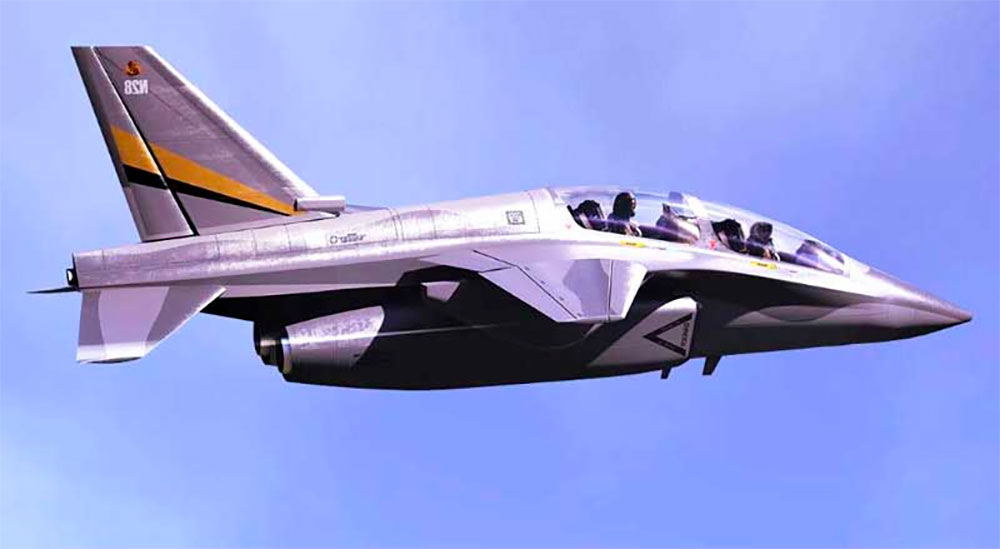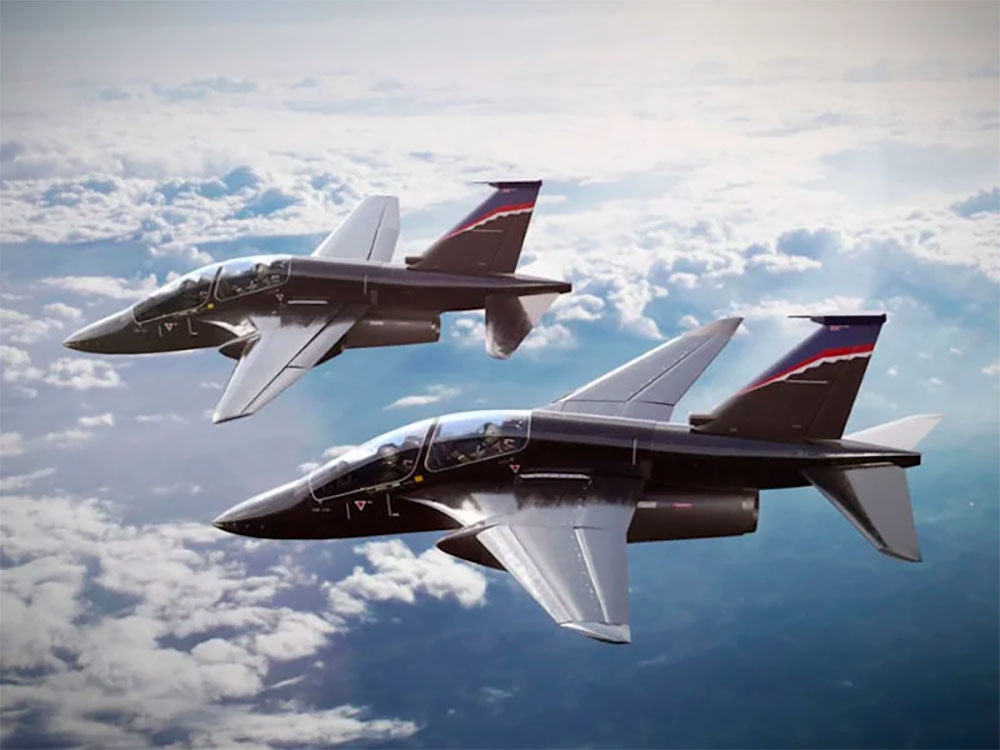The Aeralis Dart Jet is a modular military trainer aircraft designed for versatile pilot training, featuring interchangeable components to adapt to various training missions.
The Aeralis Dart Jet is a modular military trainer aircraft developed in the United Kingdom. Designed with a common core fuselage, it allows for rapid reconfiguration by swapping wings, engines, and avionics to suit different training missions. The aircraft measures approximately 39.4 feet (12 meters) in length, with a wingspan of 31.2 feet (9.5 meters). It accommodates two crew members in a tandem seating arrangement. Powered by a Honeywell/ITEC F124 low-bypass turbofan engine, the Dart Jet achieves a maximum speed of 350 knots (650 km/h) and a range of 1,350 nautical miles (2,500 kilometers). Its service ceiling reaches 44,300 feet (13,500 meters), with a climb rate of 10,000 feet per minute (3,048 meters per minute). The modular design aims to reduce operating costs and enhance flexibility for various pilot training requirements.
History of the Development of the Aeralis Dart Jet
In the early 2010s, the global military aviation community recognized a growing need for more adaptable and cost-effective pilot training solutions. Traditional trainer aircraft often required significant investments for each specific training role, leading to increased costs and logistical challenges. The concept of a modular aircraft that could be reconfigured for various training missions emerged as a potential solution to these issues.
In June 2015, Aeralis, a UK-based aerospace company, publicly announced the development of the Dart Jet, aiming to revolutionize military pilot training through modular aircraft design. The project sought to create a family of aircraft sharing a common fuselage, with interchangeable components such as wings and engines, allowing for rapid adaptation to different training requirements.
The Royal Air Force (RAF) took interest in the project, and in February 2021, its Rapid Capabilities Office awarded Aeralis a three-year contract to further develop the aircraft. This collaboration aimed to explore the Dart Jet’s potential applications, including its role in the Future Combat Air System (FCAS) initiative and as a possible replacement for the aging BAE Systems Hawk trainers.
Throughout its development, Aeralis partnered with several prominent organizations. Engineering consultancy Atkins contributed to the design process, while the International Turbine Engine Company (ITEC) provided expertise in propulsion systems. Additionally, Siemens offered support in digital systems integration, enhancing the aircraft’s technological capabilities.
In October 2022, Airbus UK conducted wind tunnel testing to validate the Dart Jet’s aerodynamic properties. These tests were crucial in refining the aircraft’s design and ensuring its performance met the required standards. Despite initial plans for a first flight in 2024, as of February 2025, the Dart Jet has yet to take to the skies. Development efforts continue, with a focus on achieving operational readiness in the near future.
The Aeralis Dart Jet does not have a NATO reporting name, as it remains under development and has not yet entered operational service.

Design of the Aeralis Dart Jet
The Aeralis Dart Jet’s design centers on a modular architecture, featuring a common core fuselage that serves as the foundation for various configurations. This fuselage measures approximately 39.4 feet (12 meters) in length, providing a compact yet versatile platform suitable for multiple training roles.
One of the key design features is the ability to interchange wings and tailplanes to modify the aircraft’s performance characteristics. In its basic trainer configuration, the Dart Jet is equipped with straight wings and tailplanes, optimizing it for stability and control at lower speeds. This setup is ideal for novice pilots undergoing initial jet training. Conversely, the advanced trainer variant incorporates swept wings and tailplanes, enhancing aerodynamic efficiency and enabling higher speed operations, which are essential for preparing pilots for frontline combat aircraft.
The aircraft’s wingspan varies depending on the configuration but generally spans 31.2 feet (9.5 meters). The modular wing design not only allows for performance adjustments but also facilitates easier maintenance and potential future upgrades. The ability to swap out wings and other components reduces the need for multiple specialized aircraft, thereby streamlining the training fleet and associated logistics.
The Dart Jet’s propulsion system is designed with flexibility in mind. It can accommodate different engines to meet various performance requirements. The primary powerplant is the Honeywell/ITEC F124 low-bypass turbofan engine, known for its reliability and efficiency. This engine choice ensures that the aircraft delivers consistent performance across its different configurations.
The cockpit is another area where the Dart Jet excels in versatility. It features a glass cockpit layout with advanced avionics systems that can be tailored to simulate various operational environments. This includes synthetic radar displays, missile simulation capabilities, and electronic warfare training tools. Such features are crucial for acclimating pilots to the complex systems they will encounter in frontline combat aircraft. The cockpit layout is designed to be reconfigurable, allowing instructors to modify the interface based on the specific training mission. This adaptability ensures that pilots receive a training experience tailored to the operational aircraft they will eventually fly.
The aircraft’s airframe is constructed using composite materials to reduce weight while maintaining structural integrity. This choice enhances fuel efficiency and extends the operational lifespan of the aircraft. The use of composites also contributes to lower maintenance costs, as these materials are less susceptible to corrosion compared to traditional metal airframes.
The Aeralis Dart Jet incorporates an open-architecture avionics system, allowing for software and hardware updates without extensive modifications. This future-proof approach ensures that the aircraft remains relevant as avionics technology evolves. The system is designed to support both Western and non-Western avionics, making it a viable option for a wide range of air forces.
The modular design presents advantages and some potential drawbacks. The primary advantage is cost reduction, as multiple training roles can be fulfilled using a single aircraft type. This streamlines maintenance, logistics, and pilot transition between different training stages. However, modularity may introduce some compromises in performance, as a single airframe must accommodate various configurations rather than being optimized for a specific role. Additionally, while the ability to swap out wings and engines enhances flexibility, it may introduce complexities in certification and operational standardization.
Performance of the Aeralis Dart Jet
The Aeralis Dart Jet is powered by the Honeywell/ITEC F124 turbofan engine. This low-bypass engine is commonly used in trainer and light attack aircraft, offering a balance of power and fuel efficiency. It generates 6,300 lbf (28 kN) of thrust, providing sufficient acceleration and climb performance for training missions.
In terms of speed, the Dart Jet has a maximum speed of 350 knots (650 km/h). This speed is adequate for both basic and advanced training missions, allowing pilots to transition smoothly to high-performance fighter aircraft. While this speed is lower than frontline fighters, it is comparable to other jet trainers such as the BAE Hawk T2 (550 knots / 1,020 km/h) and the Aermacchi M-346 (590 knots / 1,095 km/h).
The aircraft has a service ceiling of 44,300 feet (13,500 meters), which enables high-altitude training exercises and basic exposure to combat flight conditions. The climb rate is estimated at 10,000 feet per minute (3,048 meters per minute), ensuring that the aircraft can quickly reach operational altitudes.
With a range of 1,350 nautical miles (2,500 kilometers), the Dart Jet has endurance suitable for extended training missions. This allows for more flexible sortie planning, reducing the need for frequent refueling. In comparison, the T-50 Golden Eagle has a range of 1,150 nautical miles (2,130 kilometers), making the Dart Jet a competitive option in terms of endurance.
The aircraft’s maneuverability is designed to replicate the handling characteristics of modern fighter jets. While it does not match the agility of dedicated combat aircraft, its wing-loading and thrust-to-weight ratio provide a realistic training environment. The fly-by-wire system ensures precise control, enabling pilots to develop skills applicable to more advanced fighters.
Compared to competing trainers, the Dart Jet offers a balance between cost, performance, and adaptability. The M-346 Master and T-50 Golden Eagle offer higher speeds and advanced combat capabilities, but at a significantly higher procurement and operating cost. The BAE Hawk remains a direct competitor, though its fixed design lacks the modularity of the Dart Jet.
Variants of the Aeralis Dart Jet
The Aeralis Dart Jet is expected to have multiple variants, each designed for a specific role. The primary configurations include:
- Basic Trainer Variant: This version features straight wings and a simplified avionics suite for early-stage pilot training. It focuses on stability and ease of handling.
- Advanced Trainer Variant: Equipped with swept wings and enhanced avionics, this version prepares pilots for high-performance fighter aircraft. It includes simulated radar systems and weapons training features.
- Light Combat Variant: This configuration integrates external hardpoints for carrying weapons such as air-to-air missiles, air-to-ground munitions, and gun pods. It is designed for light attack missions and advanced tactical training.
- Red Air Aggressor Variant: This version is intended for adversary training, simulating potential threats in air combat exercises. It can be configured to mimic the performance characteristics of enemy aircraft.
Each variant is based on the same core fuselage, reducing production and maintenance costs. The ability to convert a trainer aircraft into a light combat platform enhances its versatility.

Military Missions of the Aeralis Dart Jet
The primary mission of the Aeralis Dart Jet is military pilot training. It is designed to provide a seamless transition from basic flight instruction to advanced combat training, covering multiple training phases within a single platform.
Armament and Combat Training
The light combat variant of the Dart Jet is equipped with up to four external hardpoints, allowing it to carry a combination of:
- Air-to-air missiles (e.g., AIM-9 Sidewinder, IRIS-T)
- Air-to-ground munitions (precision-guided bombs, unguided rockets)
- Gun pods (optional, for gunnery training and close air support simulations)
While it is not intended to serve as a frontline fighter, the ability to carry weapons provides trainees with realistic exposure to combat scenarios. The fire control system is designed to replicate the systems used in modern combat aircraft, ensuring pilots develop relevant skills.
Training Missions
The Dart Jet is capable of performing all phases of jet training, including:
- Basic flight training – Providing new pilots with fundamental jet handling experience.
- Advanced flight training – Simulating high-speed maneuvers and combat scenarios.
- Weapons training – Practicing target acquisition, missile deployment, and ground attack tactics.
- Electronic warfare training – Exposing pilots to radar and countermeasure operations.
The modular design allows for mission customization. Instructors can configure the aircraft for different training objectives without requiring an entirely separate fleet.
Operational Deployment and Sales
As of 2025, the Aeralis Dart Jet has not yet entered service, but multiple air forces have expressed interest in its capabilities. The Royal Air Force (RAF) has supported its development, and discussions continue regarding its potential role in replacing the aging BAE Hawk trainers.
Other potential customers include air forces seeking a cost-effective multi-role training platform. Countries looking for affordable jet trainers with optional light attack capabilities may find the Dart Jet an attractive alternative to more expensive Western and Eastern trainer aircraft.
If adopted, the Dart Jet could eventually replace a range of aging trainer fleets, offering a modern and flexible training solution. However, until its first flight and final performance evaluation, its operational viability remains under assessment.
As development progresses, the Dart Jet’s first flight will determine its viability. If successful, it could become a widely adopted solution for air forces requiring adaptable, cost-effective pilot training.
Back to the Trainers section.